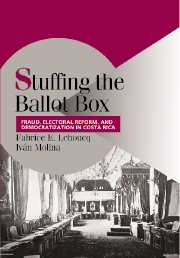Book contents
- Frontmatter
- Contents
- List of Tables and Figures
- Preface
- INTRODUCTION
- 1 ELECTORAL FRAUD DURING INDIRECT AND PUBLIC ELECTIONS, 1901–12
- 2 INSTITUTIONAL CHANGE, ELECTORAL CYCLES, AND PARTISANSHIP, 1910–4
- 3 ELECTORAL FRAUD DURING THE PUBLIC BALLOT,1913–23
- 4 INSTITUTIONAL CHANGE, ELECTORAL CYCLES, AND PARTISANSHIP, 1924–8
- 5 ELECTORAL FRAUD DURING THE SECRET BALLOT, 1925–48
- 6 POLITICAL POLARIZATION, ELECTORAL REFORM, AND CIVIL WAR, 1946–9
- CONCLUSION: BALLOT-RIGGING AND ELECTORAL REFORM IN COMPARATIVE PERSPECTIVE
- Index
- Cambridge Cultural Social Studies
1 - ELECTORAL FRAUD DURING INDIRECT AND PUBLIC ELECTIONS, 1901–12
Published online by Cambridge University Press: 16 July 2009
- Frontmatter
- Contents
- List of Tables and Figures
- Preface
- INTRODUCTION
- 1 ELECTORAL FRAUD DURING INDIRECT AND PUBLIC ELECTIONS, 1901–12
- 2 INSTITUTIONAL CHANGE, ELECTORAL CYCLES, AND PARTISANSHIP, 1910–4
- 3 ELECTORAL FRAUD DURING THE PUBLIC BALLOT,1913–23
- 4 INSTITUTIONAL CHANGE, ELECTORAL CYCLES, AND PARTISANSHIP, 1924–8
- 5 ELECTORAL FRAUD DURING THE SECRET BALLOT, 1925–48
- 6 POLITICAL POLARIZATION, ELECTORAL REFORM, AND CIVIL WAR, 1946–9
- CONCLUSION: BALLOT-RIGGING AND ELECTORAL REFORM IN COMPARATIVE PERSPECTIVE
- Index
- Cambridge Cultural Social Studies
Summary
Introduction
How did parties compete for power at the height of presidential omnipotence? How did they rig election results? Did sociological and institutional factors shape ballot-rigging strategies? These are the questions we explore in this chapter.
According to conventional wisdom, politics in prereform Costa Rica was no different than in the other so-called oligarchies of Latin America. To stay in power, incumbents will pack the electoral registry with the names of dead or nonexistent individuals to allow their followers to vote repeatedly. They could put polling stations in places inaccessible to their rivals; worse still, they could even stop hostile voters from casting their ballots. In conjunction with their opponents, they could restrict access to the franchise to keep subordinate groups from threatening their control of a largely corrupt political system. Indeed, one analyst has gone so far as to argue that politics in prereform Costa Rica was no different than in Guatemala. However they did so, several analysts claim, it was a relatively straightforward matter for incumbents to manufacture favorable electoral majorities. This is what made politics in prereform Costa Rica the predictable, elite-dominated affairs typical of oligarchic regimes.
This chapter sheds light on the validity of conventional portraits by examining the impact of ballot-rigging on political competition when presidents were at their most powerful.
- Type
- Chapter
- Information
- Stuffing the Ballot BoxFraud, Electoral Reform, and Democratization in Costa Rica, pp. 34 - 62Publisher: Cambridge University PressPrint publication year: 2002



